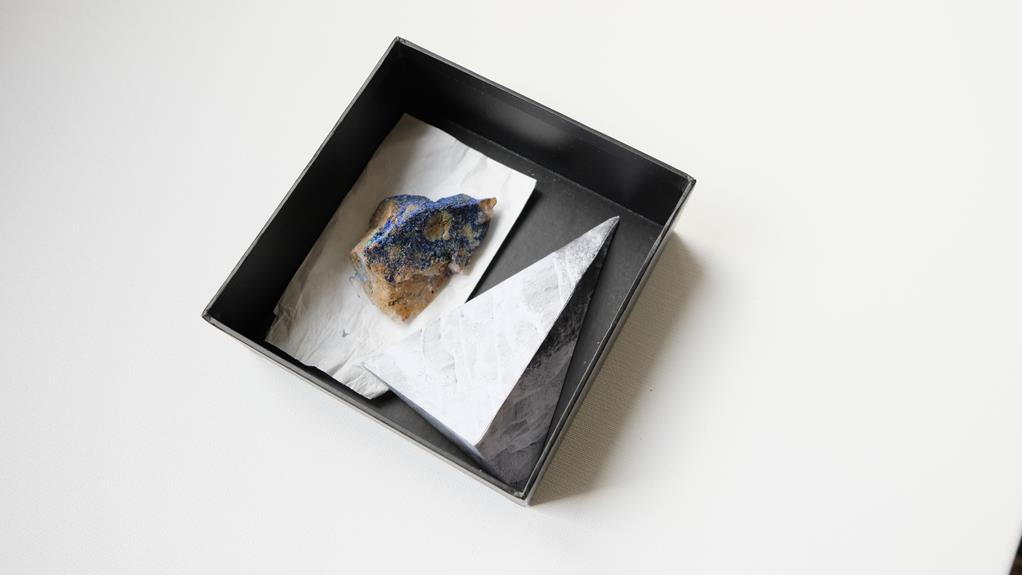Hey there! Ever wondered how crystals get their stunning colors? Well, buckle up because we're about to dive into the fascinating world of crystal coloration.
From the role of impurities to the influence of atomic arrangement and crystal structure, we'll explore the various factors that contribute to the vibrant hues of these mesmerizing gems.
So, get ready to unlock the secrets behind the enchanting colors of crystals. Let's get started!
The Role of Impurities in Crystal Coloration
You'll learn about the importance of impurities in crystal coloration. Impurities play a significant role in giving crystals their vibrant colors. These impurities are foreign elements that are present in the crystal lattice structure. They can be introduced during the crystal's formation process or through external factors.
The presence of impurities alters the crystal's atomic structure, causing the absorption or reflection of specific wavelengths of light. This absorption or reflection leads to the perception of color. For example, the presence of chromium impurities in a crystal can result in a red color, while iron impurities can produce a green hue.
The type and concentration of impurities determine the color intensity and shade of the crystal. Therefore, the study of impurities is crucial in understanding and manipulating crystal coloration.
Atomic Arrangement and Crystal Color
To understand crystal color, you need to examine the atomic arrangement within the crystal lattice. The way atoms are arranged in a crystal structure can have a significant impact on its color. Different atomic arrangements can result in different energy levels and absorption of light, leading to a variation in color. For example, in a crystal with a regular atomic arrangement, light can be absorbed and re-emitted in specific wavelengths, giving the crystal a distinct color. On the other hand, if the atomic arrangement is irregular or distorted, it can cause the crystal to be colorless or exhibit a range of colors. The table below provides a visual representation of how atomic arrangements can influence crystal color.
| Atomic Arrangement | Crystal Color |
|---|---|
| Regular | Blue |
| Irregular | Colorless |
| Distorted | Multicolored |
| Ordered | Green |
| Disordered | Red |
Understanding Light Absorption and Crystal Color
To understand crystal color, you'll need to know how light is absorbed by the crystal and how it affects its color.
When light shines on a crystal, it interacts with the atoms and molecules within the crystal structure. These atoms and molecules have electrons that can absorb certain wavelengths of light.
The absorbed light energy causes the electrons to move to a higher energy state. The remaining unabsorbed light is what we see as the crystal's color. The absorbed light energy is converted into heat or re-emitted as light of a different wavelength, which gives the crystal its characteristic color.
Different crystal structures and elements result in different absorption patterns and colors.
The Influence of Crystal Structure on Color Expression
The crystal structure plays a significant role in determining the expression of color. Different crystal structures can give rise to different colors due to the way they interact with light.
For example, in some crystals, the arrangement of atoms allows for the absorption of certain wavelengths of light, while reflecting others. This selective absorption leads to the expression of specific colors.
Additionally, the crystal structure can affect the way light is scattered or diffracted within the crystal, influencing the overall color perception.
The presence of impurities or defects in the crystal structure can also impact color expression by introducing additional energy levels that can interact with light.
Therefore, understanding the crystal structure is crucial in explaining the diverse range of colors observed in crystals.
Factors Affecting Crystal Color Variations
Color variations in crystals can be influenced by several factors, such as impurities, defects, and environmental conditions.
These factors can affect the way light interacts with the crystal, leading to different colors and hues.
Here are some key factors that contribute to crystal color variations:
- Impurities: When foreign elements are present in a crystal lattice, they can absorb or reflect certain wavelengths of light, resulting in a change of color. For example, copper impurities can give quartz crystals a blue or green color.
- Defects: Crystal defects, such as vacancies or dislocations, can also alter the crystal's color. These defects can create energy states within the crystal that interact with light, causing color variations.
- Environmental conditions: Factors like temperature, pressure, and exposure to radiation can all impact crystal color. Changes in these conditions can lead to different arrangements of atoms within the crystal lattice, affecting the way light is absorbed and transmitted.
Understanding these factors can help explain the stunning array of colors seen in crystals and provide insights into their formation and properties.
Conclusion
So there you have it! Crystals get their beautiful colors from a combination of impurities, atomic arrangement, light absorption, and crystal structure. It's truly amazing how these factors come together to create such stunning variations in color.
As the saying goes, 'Colors are the smiles of nature.' And indeed, the colors of crystals are nature's way of showing off its vibrant and enchanting beauty.








